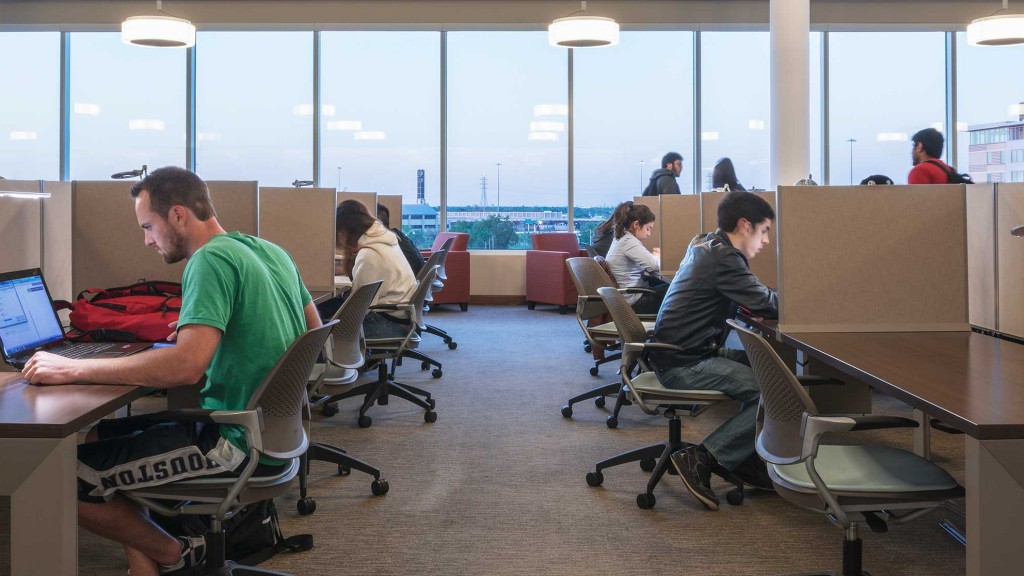Why do students really go to the library?
Future of the Academic Library
What We Did
We are conducting a multiyear investigation to understand what’s working, what isn’t, and what the future might hold for today’s academic libraries. Our first step was to conduct observational analyses of seven academic libraries in the US and UK. We recorded detailed student usage patterns to provide a “current state” of the library via a web-based observational tool that documents usage patterns over time. This data provides a perspective on how today’s libraries are really being used—and insights that may inform how to improve them for the future.
The Context
Academic libraries are at a pivotal crossroads. New technologies, changing study habits, and efforts to manage the rising costs of higher education put both their facilities and purpose in flux—questioning the utility of books in a digital age and even posing larger questions about the relevance and purpose of these storied institutions. As colleges and universities grapple with this changing educational context, there is a growing need to understand what’s next for the library.
While digital and social media and ubiquitous access to the Internet call into question the need to dedicate space to rows and rows of stacks, previous Gensler research points to some aspects—both symbolic and functional— of today’s libraries that endure. Today’s students prefer to study alone and seek quiet spaces to study most effectively. The library is by far the favored place for this activity, with the majority of students ranking it as the best place to study or work alone on campus.
The Results
Individual focus work by far the dominant activity observed in today’s acedemic library, outranking any other activity by a factor of nearly 3:1 and indicating that to students the primary value and use of the library is still in solitary, focused effort. While the dominance of focus work is consistent, libraries do appear to have a daily rhythm in which the ratio of collaborative to individual activities is lowest in the morning and highest in the afternoon—though even at its most social points, more than half of library occupants remain engaged in individual, focused work.
From previous research, we know that the library is the place many students prefer for individual study, yet today’s libraries are drastically underutilized. On average, library utilization rates (as measured by number of used seats vs. number available) are strikingly low—below 25%. This appears to be the result of many areas meant to support group work— open study areas and private study rooms—being frequently occupied by one student studying alone.
Observation of tool and technology use throughout the day also showed a notable rhythm. While computers outpace the use of books on average, the use of books, computers, and tablets spikes in the afternoon, then drops off toward the evening as a greater percentage of students shift to pen and paper and more team-based, collaborative learning. Importantly, the overall rate of observed tool usage never goes above 50%—at any given time, half of the students in the library were using neither books nor technology.
What This Means
Libraries are about more than books. For students—yesterday’s, today’s, and tomorrow’s— the core purpose of the library is its physical and symbolic presence as a place where scholarship is supported and respected. Students, even those not looking for books, continue to seek library spaces as the place to complete their individual work.
You can increase capacity without increasing space. Money and space are both at a premium— opportunities to better leverage existing resources and facilities are necessary to keep libraries relevant and performing at their best. By prioritizing the favored workspace types, you can serve more students in the same amount of space.
Individual work should be the priority. This doesn’t mean giving everyone an enclosed room. The utilization rates of study stations and open seating arrangements in our investigation illustrates the point—both are largely open, but study stations provide clearly defined individual work areas and are occupied at twice the rate of open seating on average.
Your library has a rhythm of its own. Understanding the rhythm and current utilization patterns of a library is an opportunity to realign spaces to best support student demands—increasing the opportunity for them to find the spaces they need by maximizing the spaces available.
What’s Next?
To understand how tomorrow’s libraries can better support evolving student needs, we are launching a nationwide survey of college students to understand how they’re studying and using the library today and their preferences for the future. Our team is also exploring hybrid space and furniture typologies to better address the tension between spaces intended for individual work and those meant for group work. We believe these hybrid solutions are necessary to support the changing activities libraries must accommodate over the course of a day, week, and school year—allowing changes in use to occur in real time with minimal rearrangement of furniture.
Learn More
Team
Mark Thaler, Maddy Burke-Vigeland, Kimberly Hickson, David Broz, Ambrosia Anderson, Christine Barber, Theodora Batchvarova, Allison Brandt, Kimberly Busch, Todd Carr, Rachel Doe, Marin Gertler, Tom Heffernan, Karen Cribbins-Kuklin, Rachel Ganin, Julissa Lopez-Hodoyan, Nick McFadden, Mark McMinn, Christopher Miller, Melissa Mizell, Rebecca Muck, Maria Nesdale, Tim Pittman, Stacy Reed, Benjamin Regnier, Santiago Rivera Gonzalez, Oliver Sanchez, Oren Schumaker, Sarah Stanley, Scott Wightman
Year Completed
2014
Comments or ideas for further questions we should investigate?
